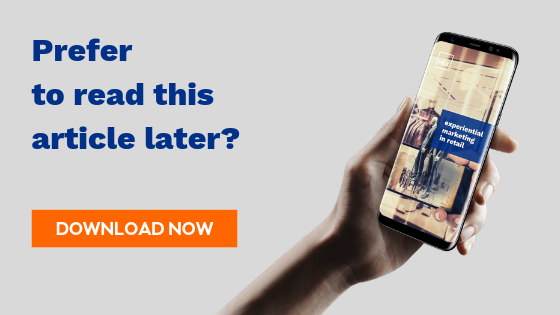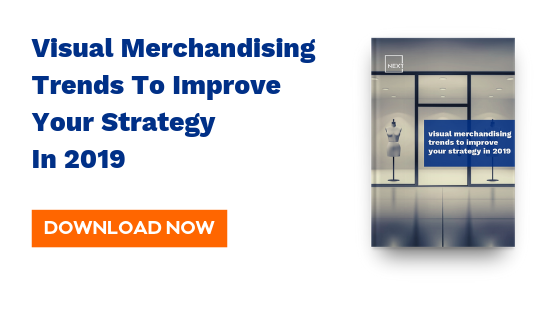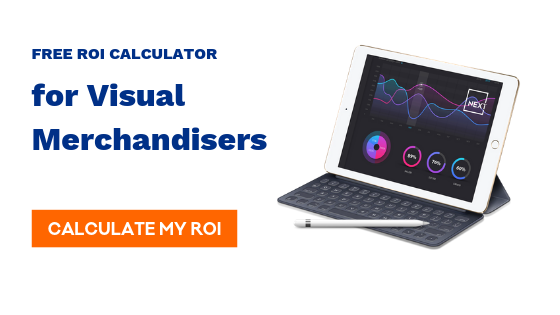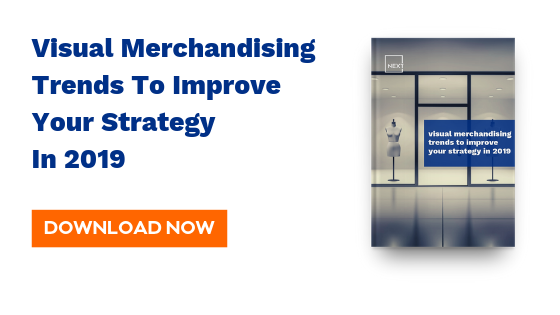
In today’s retail ecosystem, trying to get the word out about your product isn’t enough. You need to give your customers something more. They need an experience. As digital trends continue to bite away at retailers’ profit margins, staying afloat in the increasingly competitive market is tough. But, some retailers are doing more than surviving; they’re thriving.
Finding a way to deliver customers a consistent, wonderful, and imaginative experience is a surefire way to get them to purchase more product and become brand evangelists. The art of creating that experience is called experiential marketing, and its one of the fastest rising and most substantial forms of marketing in the retail world today.
This post is a comprehensive overview that will give you a detail description of experiential marketing, back it up with some statistics, and show you some great examples of experiential marketing that you can use as a trampoline for your own campaigns.
Let’s dive in!

Experiential marketing (or engagement marketing or live marketing) is a marketing strategy that’s focused on pushing people to experience a brand through emotions and senses. While most traditional marketing strategies are focused on making customers aware of products, experiential marketing immerses customers in the product itself in order to boost brand image, evoke emotions, and create deep, lasting customer-product relationships.
To achieve this, marketers use a variety of methods — including visual merchandising, PR stunts, and events. The ultimate goal is to give customers the opportunity to develop deep meaningful relationships with your products, emotionally connect with your brand, and improve their lifetime value (LTV.)
“What we’re really trying to do is engage with the consumer community so deeply, that they begin to take on the task of evangelising the brand themselves.” – David Rich
The primary purpose of traditional marketing is advertising. This means that traditional marketing methods (social media, ads, billboards, etc.) are used to inform customers about your products or services. This can be done in a variety of ways, but, typically, traditional marketers use funnel analytics and customer capture metrics as a barometer of success.
Experiential marketing, on the other hand, focuses on immersing customers in your products. As the name implies, experiential marketing is all about the customer experience — whether that be in-store, online, or at an event. It’s important to note that both traditional and experiential marketing have similar goals (engagement, return on investment, sales, etc.) but they are measured using wildly different criteria.
To put it simply, traditional marketing wants to inform your customers about your product, while experiential marketing wants to let your customers experience that product via emotional bonds and senses triggers. Typically, experiential marketing is looking to boost your customers lifetime value, by giving them a positive association with your brand and increasing their engagement levels.
Typically, we like to think of experiential marketing as live events and visual merchandising — but there are plenty of one-off engagement triggers that would certainly count as experiential marketing.
Note: Experiential marketing is also known as live marketing, engagement marketing, and participation marketing.

Now that we know what experiential marketing is and how it differs from traditional marketing, let’s talk about how it’s applicable to retail stores. The world of retail is rapidly changing. Not only is competition rising in the physical world (other retailers, major outlets, etc.) but the digital world has put immense pressure on the retail world. Amazon’s 2-day shipping and the prevalence of Shopify-powered eCommerce stores that saturate Google search results has forced retailers to adjust, adapt, and overcome the barriers of the new world.
Let’s be clear — retail is still very much alive. In fact, 56% of shoppers will stick to retail simply because they can touch, feel, and experience merchandise. That’s the brick-and-mortar retailer’s value proposition. Customers can experience products before they buy them. Leveraging this experience is critical if retailers want to stay afloat in trying times. There’s a reason that over 33% of retailers say that the personalisation and experience are their primary goals over the next few years, and 77% of marketers use experiential marketing as a key part of their brand’s overall strategy. It works!
Experiential marketing is all about leveraging what makes brick-and-mortar retail strong, the experience. But, it’s one thing to say that experiential marketing is important for retail stores — it’s another thing to prove it is. So, let’s get our statistician glasses on and get proving.
There are two primary ways that experiential marketing drives retailers — sales and branding. To be clear, experiential marketing is the marketing term for immersing customers in products, while visual merchandising and events are the mechanisms that perform the immersion.
Let’s go over some statistics that show you how powerful both events and visual merchandising can be when applied to the retail environment.
Event marketing
Visual merchandising (in-store)

Now that we’ve gone over the mechanisms that make experiential marketing strategy powerful, let’s take a look at some real-to-life examples of experiential marketing at play. In particular, we’re going to look at an example of four different kinds of experiential marketing campaigns — VIP events, brand activation, public live events, one-off events, and retail visual merchandising.
When it comes to live event parties, Smirnoff has been a reigning champ for some time. You might think that the parties are natural (due to the nature of the company,) but Smirnoff has been playing with experiential marketing for a long time. In fact, they were hosting “Smirnoff Experience” events in 2009.
This “Smirnoff Event” took place in 2010, and it was certainly unique. Inspired by the work of Roy Lichtenstein — famous American pop artist — Smirnoff created the “Graphic” party, which was a comic book themed party/event for influencers, execs, etc.
While simply having a comic-themed party would be cool enough, Smirnoff took the event to another level.
First, consumers were sent invitations in the form of comic books that displayed a comic of a person opening that comic on the cover. Already, Smirnoff is engaging everyone with a story. When they arrived, the walls were painted as another comic frame of them arriving at the party. This method of making the guests feel like they were in the comic itself was continued throughout the night. The scenery of the comic changed as the party progressed, and, eventually, several of the characters in the comic came-to-life.
Needless to say, Smirnoff went all out on this event, and it stands the test of time as an absolutely incredible live event and experiential marketing campaign.
What can you steal?
Tell your customers a story where they’re the hero. Make your customers feel like they are living out a personalised, individual experience at each event. You can do this by customising invitations, immersing them in a gamified app, or simply giving them extra attention. Everyone wants to feel like they’re the protagonist — make them one!
Some companies create spectacular activations by throwing glitz-and-glamour parties, while others prefer the good old “drop an ice block in the middle of town” method. JetBlue definitely prefers the latter.
In this spectacular experiential marketing campaign, JetBlue dropped 6×6 foot ice blocks filled with prizes into the center of New York City. The rules were simple, you can attempt to chip away at the ice and win a prize, but you had to use whatever you had on you. People were chipping away with shoes, credit cards, belt buckles, and even hammers.
Talk about an elevated giveaway! Not only did this score JetBlue a ton of press, but it also immersed the public into a gamified branding event.
What can you steal?
Creative and well-executed one-off events can be a massive boon to your brand image. If you can get people to participate in your brand and your products, you’re going to create positive emotional triggers with them for the rest of their lives. Do you think all of those people scraping away at ice are going to remember the name JetBlue? You bet they will!
This is probably the most widely memorable experiential campaign on this list, and it’s certainly one for the record books. In fact, we would say that this event solidified Red Bull as a brand, and it’s still a metric to be measured against for other experiential marketers.
In 2012, Australian skydiver Felix Baumgartner dived from space as part of a widely marketed Red Bull event. Not only did he leap from a distance of 24 miles from a hot air balloon, but he was also the first human ever to break the sound barrier without any equipment. This was during a time where RedBull was still trying to cement the idea of “extreme sports” and “RedBull” as synonymous terms.
This event was the catalyst for that mental connection. 8 million viewers watched the event live, and RedBull still uses the Stratos event as a branding tool.
When you think of extreme sports, you probably think of RedBull; this event is a large part of that.
What can you steal?
Use experiential marketing as a tool to create brand associations in peoples minds. When people think about Christmas, they think Coca Cola. You want that type of connection. Experiential marketing is a potent tool that can create these associations.
As a brand, Glossier is hinged to social media. People experience Glossier through its founder Emily Weiss. Emily ran an extremely successful blog Into the Gloss, which she leveraged to create a makeup brand — Glossier. For years, Glossier existed as an eCommerce phenomenon. But, with the retail market retaining a large chunk of customers due to the experience, Emily opened her Glossier flagship location in New York after years of dipping her toe in the retail market.
Glossier’s first physical location is all about the customer experience. The entire store is designed around the idea of driving through a massive pink desert. Based on Arizona’s Antelope Canyon, the Glossier store’s walls are soft pink and rippled like the canyons. The sounds of the desert (recorded on location!) play throughout the halls. Eventually, customers emerge into a giant pink reflective room. The entire store is beautiful, and it’s been the source of a ton of social media sharing — which was a massive goal according to Emily.
In fact, the main showroom is filled with flowers, mirrors, and plenty of aesthetic attributes that make it perfect for a quick selfie in our social-media-driven age. Of course, everything is their trademark pink colour (literally everything.)
Glossier’s flagship location is more of an experience than it is a store, which is precisely what they wanted!
The results? Glossier’s store now does more business per-square-inch than Apple!
What can you steal?
Experience is everything! Customers go to brick-and-mortar retail stores for an experience, not just a product. Leveraging that in-store experience by staying incredibly on-brand and unique will keep your customers coming back and your brand fresh on their minds.
Experiential marketing is a marketing strategy that’s used to push customers to engage with brand experiences on an emotional level. Successful experiential campaigns will leverage a consistent image with immersive customer activation techniques. Ultimately, you want your customer to form a mental connection with your brand that sparks emotions and converts them into brand evangelists.
This can be done via events, one-off activations, visual merchandising, brand experience marketing and other live methods of marketing. Retailers that leverage experiential marketing will stay a step ahead of the competition, and remain competitive in the digital age.
Use these examples as a catalyst for your own unique campaigns, and see how powerful experiential marketing can be for your brand.

We'd love to send you innovative tips, news and offers from the world of print and marketing.
Client experience officers are available to answer any questions you have. Use the form below to quickly let us know what you need!